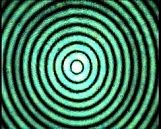Trapping Particles with Light or Charge
Detailed studies of aerosols can be performed by isolating a single particle, using an optical or electrostatic trap, and studying the properties of the particle directly and non-intrusively with optical spectroscopy. We use both optical techniques, for trapping and manipulating particles with light, and electrodynamic traps, for balancing the weight of a particle with an electrostatic force. More specifically, the three types of trap we work with are.
Aerosol optical tweezers

Holographic optical tweezers allow us to capture and manipulate many micron-sized particles at the same time. We can vary the gas phase composition (relative humidity, ozone concentration etc.) and pressure (down to 2 kPa) around the particle. Particles can be imaged by brightfield microscopy to characterise morphology, track particle position and measure droplet shape. Indeed, particles can then be manipulated to a point of coalescence to measure particle viscosity and surface tension and to initiate chemical reactions. The inelastic backscattered Raman light can be used to characterise particle composition, refractive index and size with extremely high accuracy.
Bessel beams

BBs allow us to guide particles (<5 μm diameter and as small as 400 nm) over macroscopic distances (millimetres). We can probe particle size by light scattering, recording the diffracted light pattern over a range of angles, can capture accumulation mode particles, and can confine many particles to the bright central core of a BB. Traps can be formed from two counter-propagating BBs or from a gas flow countering the radiation pressure exerted on a particle from a single BB.
Electrodynamic Balances

EDBs have been used for many decades to capture single charged particles to measure their change in mass over time. We have three EDBs that can be combined with elastic light scattering to measure particle size and Raman spectroscopy to measure composition. In a new design, we can also change the gas composition around the particle in a sub-second timeframe. The evolving size can be measured with 10 nm accuracy on a sub-10 ms timescale. Droplets from different droplet-on-demand generators can be injected into the trap in sequence to compare their evaporation kinetics.
